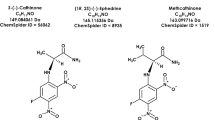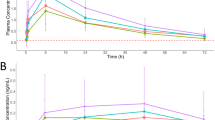Abstract
Cathinone is the principal psychostimulant present in the leaves of khat shrub, which are widely used in East Africa and the Arab peninsula as an amphetamine-like stimulant. Cathinone readily undergoes metabolism in vivo to form less potent cathine and norephedrine as the metabolites. However, the presence of cathine and norephedrine in biological fluids cannot be used as an indicator of cathinone administration. The metabolism of pseudoephedrine and ephedrine, commonly used in cold and allergy medications, also produces cathine and norephedrine, respectively, as the metabolites. Besides, cathine and norephedrine may also originate from the ingestion of nutritional supplemental products containing extracts of Ephedra species. In Canada, ephedrine and norephedrine are available for veterinary use, whereas cathinone is not approved for human or veterinary use. In this article, the detection of cathinone in equine after administration of norephedrine is reported. To the best of our knowledge, this is the first such report in any species where administration of norephedrine or ephedrine generates cathinone as the metabolite. This observation is quite significant, because in equine detection of cathinone in biological fluids could be due to administration of the potent stimulant cathinone or the nonpotent stimulant norephedrine. A single oral dose of 450 mg norephedrine was administered to four Standardbred mares. Plasma and urine samples were collected up to 120 h after administration. The amount of cathinone and norephedrine detected in post administration samples was quantified using a highly sensitive, specific, and validated liquid chromatography–tandem mass spectrometry method. Using these results, we constructed elimination profiles for cathinone and norephedrine in equine plasma and urine. A mechanism that generates a geminal diol as an intermediate is postulated for this in vivo conversion of norephedrine to cathinone. Cathinone was also detected in samples collected after a single intramuscular administration of 200 mg ephedrine and oral administration of 300 mg ephedrine in equine.

Electron density structure of cathinone






Similar content being viewed by others
References
Toennes SW, Kauert GF (2002) Excretion and detection of cathinone, cathine and phenylpropanolamine in urine after kath chewing. Clin Chem 28:1715–1719
Toennes SW, Harder S, Schramm M, Niess C, Kauert GF (2003) Pharmacokinetics of cathinone, cathine and norephedrine after the chewing of khat leaves. Br J Clin Pharmacol 56:125–130
Sporkert F, Pragst F, Bachus R, Masuhr F, Harms L (2003) Determination of cathinone, cathine and norephedrine in hair of Yemenite khat chewers. Forensic Sci Int 113:39–46
Toennes SW, Kauert GF (2003) Driving under the influence of khat – alkaloid concentrations and observations in forensic cases. Forensic Sci Int 140:85–90
Brenneisen R, Fisch HU, Koelbing U, Geisshusler S, Kalix P (1990) Amphetamine-like effects in humans of the Khat alkaloids cathinone. Br J Clin Pharmacol 30:825–828
Paul BD, Cole KA (2001) Cathinone (khat) and methcathinone (cat) in urine specimens: a gas chromatographic-mass spectrometric detection procedure. J Anal Toxicol 25:525–530
Mathys K, Brenneisen R (1992) Determination of (S)-(-)-cathinone and its metabolites (R, S)-(-)-norephedrine and (R, R)-(-) norpseudoephedrine in urine by high performance liquid chromatography with photodiode-array detection. J Chromatogr A 593:79–85
Gambaro V, Arnoldi S, Colombo ML, Dell’Acqua L, Guerrini K, Roda G (2012) Determination of active principles of Catha edulis: quali-quantitative analysis of cathinone, cathine, and phenylpropanolamine. Forensic Sci Int 217:87–92
Chappell JS, Lee MM (2010) Cathinone preservation in khat evidence via drying. Forensic Sci Int 195:108–120
Berrang BD, Lewin AH, Carroll FI (1982) Enantiomeric α-aminopropiophenones (cathinone): preparation and investigation. J Org Chem 47:2643–2647
Lee MM (1995) The identification of cathinone in khat (Catha edulis): a time study. J Forensic Sci 40:116–121
Brenneisen R, Geisshusler S (1985) Psychotropic drugs III: analytical and chemical aspects of Catha edulis Forsk. Pharm Acta Helv 60:290–301
LeBelle MJ, Lauriault G, Lavoie A (1993) Gas chromatographic-mass spectrometric identification of chiral derivatives of the alkaloids of khat. Forensic Sci Int 61:53–64
Dawson BA, Black DB, Lavoie A, LeBelle MJ (1994) Nuclear magnetic resonance identification of the phenylalkylamine alkaloids in khat using a chiral solvating agent. J Forensic Sci 39:1026–1038
Al-Meshal IA, Al-Rashood KA, Nasir M, El-Feraly F (1987) (-)-Cathinone: Improved synthesis and carbon-13 NMR assignments. J Nat Prod 50:1138–1140
Sørenson LK (2011) Determination of cathinones and related ephedrines in forensic whole-blood samples by liquid-chromatography-electrospray tandem mass spectrometry. J Chromatogr B 879:727–736
Deventer K, Van Eenoo P, Baele G, Pozo OJ, Van Thuyne W, Delbeke FT (2009) Interpretation of urinary concentrations of pseudoephedrine and its metabolite cathine in relation to doping control. Drug Test Anal 1:209–213
Tseng YL, Shieh MH, Kuo FH (2006) Metabolites of ephedrines in human urine after administration of a single therapeutic dose. Forensic Sci Int 157:149–155
Abourashed EA, El-Alfy AT, Khan IA, Walker L (2003) Review article: Ephedra in perspective – a current review. Phytother Res 17:703–712
Krizevski R, Bar E, Shalit O, Sitrit Y, Ben-Shabat S, Lewinsohn E (2010) Composition and stereochemistry of ephedrine alkaloids accumulation in Ephedra sinica Stapf. Phytochemistry 71:895–903
Chan KH, Pan RN, Hsu MC, Hsu KF (2008) Urinary elimination of ephedrines following administration of the traditional Chinese medicine preparation kakkon-to. J Anal Toxicol 32:763–767
Jiménez C, de la Torre R, Ventura M, Segura J, Ventura R (2006) Stability studies of amphetamine and ephedrine derivatives in urine. J Chromatogr B 843:84–93
North American Compendiums (2012) Antihistamine powder. http://veto.naccvp.com/index.php?m=product_view&id=1234007&key=label. Accessed 12 Oct 2012
Schneider M, Woehrl F, Boisram B (2012) Enantioselective pharmacokinetics of phenylpropanolamine in dogs. http://www.vetoquinol.com/pdf/propalin/enantioselective_pharmacokinetics_of_phenylpropanolamine.pdf. Accessed 1 Nov2012
Powers ME (2001) Ephedra and its application to sport performance: another concern for the athletic trainer. J Athl Train 36:420–424
Magkos F, Kavouras SA (2004) Caffeine and ephedrine: physiological, metabolic and performance enhancing effects. Sports Med 34:871–889
Hodges K, Hancock S, Currell K, Hamilton B, Jeukendrup AE (2006) Pseudoephedrine enhances performance in 1500-m runners. Med Sci Sport Exer 38:329–333
Pokrywka A, Tszyrsznic W, Kwiatkowska DJ (2009) Problems of the use of pseudoephedrine by athletes. Int J Sports Med 30:569–572
Barroso O, Goudreault D, Carbó Banús ML, Ayotte C, Mazzoni I, Boghosian T, Rabin O (2012) Determination of urinary concentrations of pseudoephedrine and cathine after therapeutic administration of pseudoephedrine-containing medications to healthy subjects: implications for doping control analysis of these stimulants banned in sport. Drug Test Anal 4:320–329
Strano-Rossi S, Leone D, de la Torre X, Botrè F (2009) The relevance of the urinary concentration of ephedrines in anti-doping analyses: determination of pseudoephedrine, cathine and ephedrine after administration of over-the-counter medicaments. Ther Drug Monit 31:520–526
World Anti-Doping Agency (2012) The world anti-doping code. http://www.wada-ama.org/documents/world_anti-doping_program/wadp-prohibited-list/2012/wada_prohibited_list_2012_en.pdf. Accessed 12 Jan 2013
Association of Racing Commissioners International (2012) Uniform classification guidelines for foreign substances and recommended penalties and model rule. http://arci.com/druglisting.pdf. Accessed 12 Jan 2013
Sever PS, Dring LG, Williams RT (1975) The metabolism of (-)-ephedrine in man. Europ J Clin Pharmacol 9:193–198
Feller DR, Malspeis L (1977) Biotransformation of D(-)-ephedrine and L(+)-ephedrine in the rabbit, in vivo and in vitro. Drug Metab Dispos 5:37–46
Chester N, Mottram DR, Reilly T, Powell M (2003) Elimination of ephedrines in urine following multiple dosing: the consequences for athletes, in relation to doping control. Br J Clin Pharmacol 57:62–67
Peters FT, Drummer OH, Musshoff F (2007) Validation of new methods. Forensic Sci Int 165:216–224
Association of Official Racing Chemists (2011) AORC guidelines for the minimum criteria for identification by chromatography and mass spectrometry. http://www.aorc-online.org/documents/aorc-ms-criteria-may-2011. Accessed 27 Apr 2013
May SW, Phillips RS, Mueller PW, Herman HH (1981) Dopamine β-hydroxylase: demonstration of enzymatic ketonization of the product enantiomer, S-octopamine. J Biol Chem 256:2258–2261
May SW, Phillips RS, Herman HH, Mueller PW (1982) Bioactivation of Catha edulis alkaloids: enzymatic ketonization of norpseudoephedrine. Biochem Biophys Res Commun 104:38–44
Widler P, Mathys K, Brenneisen R, Kalix P, Fisch H-U (1994) Pharmacodynamics and pharmacokinetics of khat: a controlled study. Clin Pharmcacol Ther 55(5):556–562
Brenneisen R, Geisshuesler S, Schorno X (1986) Metabolism of cathinone to (-)-norephedrine and (-) norpseudoephedrine. J Pharm Pharmacol 38(4):298–300
Guantai AN, Maitai CK (1983) Metabolism of cathinone to d-norpseudoephedrine in humans. J Pharm Sci 72(10):1217–1218
Springer D, Fritschi G, Maurer HH (2003) Metabolism of the new designer drug α-pyrrolidinopropiophenone (PPP) and the toxicological detection of PPP and 4’-methyl-α-pyrrolidinopropiophenone (MPPP) studied in rat urine using gas chromatography-mass spectrometry. J Chromatogr B 796(2):253–266
Omiecinski CJ, Vanden Heuvel JP, Perdew GH, Peters JM (2011) Xenobiotic metabolism, disposition, and regulation by receptors: from biochemical phenomenon to predictors of major toxicities. Toxicol Sci 120(S1):S49–S75
Trunzer M, Faller B, Zimmerlin A (2009) Metabolic soft spot identification and compound optimization in early discovery phases using MetaSite and LC-MS/MS validation. J Med Chem 52:329–335
Lin JH, Lu AYH (1997) Role of pharmacokinetics and metabolism in drug discovery and development. Pharmacol Rev 49:403–449
Chen ZR, Somogyi AA, Reynolds G, Bochner F (1991) Disposition and metabolism of codeine after single and chronic doses in one poor and seven extensive metabolisers. Br J Clin Pharmacol 31:381–390
Acknowledgments
This study was funded by the Canadian Pari-Mutuel Agency, a division of Agriculture and Agri-Food Canada, as part of its Equine Drug Evaluation Research Program. Drug administration and sample collection were performed by Adam Chambers and the staff of the Equine Drug Evaluation Centre in Jerseyville, Ontario.
Author information
Authors and Affiliations
Corresponding author
Additional information
Published in the topical collection Anti-doping Analysis with guest editor Christopher Harrison.
Rights and permissions
About this article
Cite this article
Yi, R., Zhao, S., Lam, G. et al. Detection and elimination profile of cathinone in equine after norephedrine (Propalin®) administration using a validated liquid chromatography–tandem mass spectrometry method. Anal Bioanal Chem 405, 9711–9722 (2013). https://doi.org/10.1007/s00216-013-7073-0
Received:
Revised:
Accepted:
Published:
Issue Date:
DOI: https://doi.org/10.1007/s00216-013-7073-0




